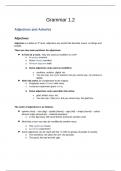Grammar 1.2
Adjectives and Adverbs
Adjectives
Adjective is a label on 4th level. Adjectives are words that describe nouns, so things and
people.
There are two main positions for adjectives:
In front of a noun: They are used as modifiers in a NP:
o A queasy moment
o Some twisted cannibal
o Window-adjacent walls
Some adjectives only used as modifiers:
southern, outdoor, digital, etc.
You can say: my digital camera, but you cannot say: my camera is
digital.
After link verbs as Complement to the subject:
o Fireplaces were throttled with vines
o A science experiment gone wrong
Some adjectives only used after link verbs:
glad, afraid, sorry, etc.
You can say: I feel glad, but you cannot say: the glad boy.
The order of adjectives is as follows:
opinion (nice) – size (big) – quality (heavy) – age (old) – shape (round) – colour
(brown) origin (American) – material (wooden)
o A nice big heavy old round brown American wooden chair
Mind that a noun can also be modified by another noun:
o This nightmare house
o A science experiment
Some adjectives can be used with the to refer to groups of people in society:
o The homeless, the deaf, the rich, the peculiar,
o The good, the bad and the ugly
,Participle adjectives: -ing and –ed
-ing and –ed adjectives are derived form verbs:
o Verb: to amaze
Adjectives: amazed, amazing
o Verb: to disappoint
Adjectives: disappointed, disappointing
What’s the difference?
o I am amazed. (describes effect- how it makes someone feel)
o I am amazing. (describes source or cause)
ADJP: adjectival phrase
Just as NP is a label on level 2, so ADJP is Adjectival phrase. The most important
word in an ADJP is an adjective.
This occurs when the adjective is used as a Complement after a link verb:
I was happy
S V Cs
ADJP
h
adjective
Adverbs
Adverbs say something about verbs: (how something is done):
I shuddered involuntarily
There are also adverbs that give information on time and place, frequency, manner, etc. in a
sentence such as: yesterday, then, now, here, there, always, simply
Adverbs are mostly formed by adding –ly to the adjective. Some spelling rules have to
be mentioned there (page 254, number 2)
Mind that adverbs say something about main verbs, (He ate hungrily) but that after
linking verbs you use adjectives (He appeared hungry)
Also note that some adjectives end in –ly already (friendly, lovely, lively)
Some adjectives and adverbs have the same form: hard, fast, early, low, etc.
Some forms are irregular
o hard – hardly (different meaning)
o good – well
, Position of adverbs
When adverbs
say something Hi drawing i really good
about adjectives s s
or other
adverbs, they S V Cs
are placed
immediately
ADJP
before the
adjective or
other adverb: mod H
adv adj
When adverbs say something about verbs (How or when or how often, etc. things are
done) they are used as adverbials.
o They can take initial or end position in a sentence.
o They can be used after be, after a modal or auxiliary, or before the main verb
(examples on page 270)
Prepositions
What is a preposition?
A preposition is a word used to link nouns, pronouns, or phrases to other words within a
sentence. They act to connect the people, objects, time and locations of a sentence.
Examples
I prefer to read in the library.
He climbed up the ladder to get onto the roof.
Please sign your name on the dotted line after you read the contract.
Go down the stairs and through the door.
He swam across the pool.
Take your brother with you.
Prepositions of Time
Basic examples of time prepositions include: at, on, in, before and after.





